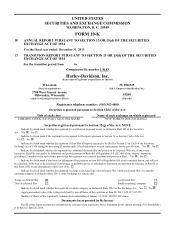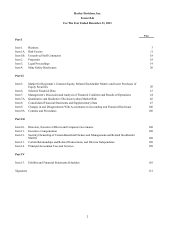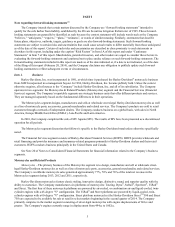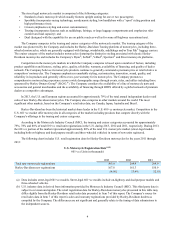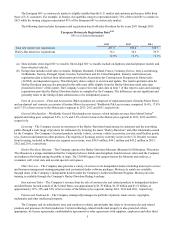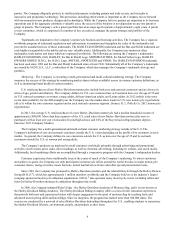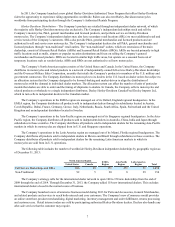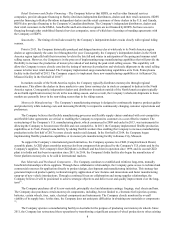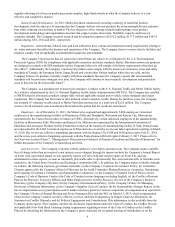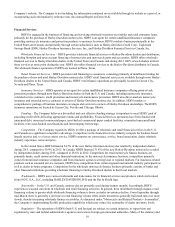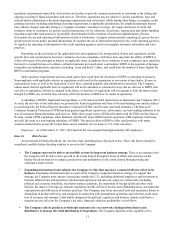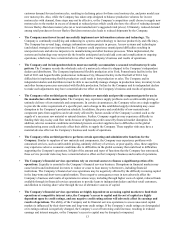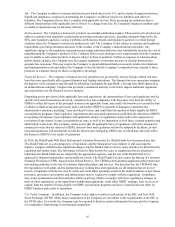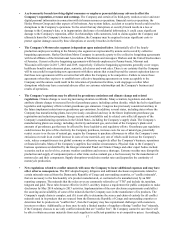Harley Davidson 2013 Annual Report Download - page 8
Download and view the complete annual report
Please find page 8 of the 2013 Harley Davidson annual report below. You can navigate through the pages in the report by either clicking on the pages listed below, or by using the keyword search tool below to find specific information within the annual report.8
Retail Customer and Dealer Financing – The Company believes that HDFS, as well as other financial services
companies, provide adequate financing to Harley-Davidson independent distributors, dealers and their retail customers. HDFS
provides financing to Harley-Davidson independent dealers and the retail customers of those dealers in the U.S. and Canada.
HDFS also provides financing to the Company’s Canadian distributor. The Company’s independent distributors, dealers and
their retail customers in the EMEA, Asia-Pacific and Latin America regions are not financed by HDFS, but have access to
financing through other established financial services companies, some of which have licensing or branding agreements with
the Company or HDFS.
Seasonality – The timing of retail sales made by the Company’s independent dealers tracks closely with regional riding
seasons.
Prior to 2013, the Company historically produced and shipped motorcycles at wholesale to its North America region
dealers at approximately the same level throughout the year. Consequently, the Company’s independent dealers in the North
America region typically built their inventory levels in the late fall and winter in anticipation of the spring and summer retail
selling season. However, the Company is in the process of implementing surge manufacturing capabilities that will provide the
flexibility to increase the production of motorcycles ahead of and during the peak retail selling season. This capability will
allow the Company to more closely correlate the timing of motorcycle production and wholesale shipments to the retail selling
season to better meet retail demand. The Company implemented surge manufacturing capabilities at its York, Pennsylvania
facility in the first half of 2013. The Company expects to implement these new manufacturing capabilities at its Kansas City,
Missouri facility in the first half of 2014(1).
In markets outside of the North America region, the Company typically distributes motorcycles through regional
warehouses. This allows the dealers in those markets to carry fewer motorcycles in stock as compared to dealers in the North
America region. Consequently, independent dealers and distributors in markets outside of the North America region typically
do not build significant inventory levels in the non-riding season, and as a result, the Company’s wholesale shipments to these
markets are generally lower in the non-riding season than in the riding season.
Motorcycle Manufacturing – The Company’s manufacturing strategy is designed to continuously improve product quality
and productivity while reducing costs and increasing flexibility to respond to continuously changing customer expectations and
preferences.
The Company believes that flexible manufacturing processes and flexible supply chains combined with cost-competitive
and flexible labor agreements are critical to enabling the Company to respond to customers in a cost effective manner. The
restructuring of the Company’s U.S. manufacturing plants, which commenced in 2009 and ended in 2013, was instrumental in
allowing the Company to become more flexible and cost competitive. In 2013, the Company implemented flexible production
capabilities at its York, Pennsylvania facility by adding flexible workers thus enabling the Company to increase manufacturing
production in the first half of 2013 to more closely match retail demand. In the first half of 2014, the Company began
implementing flexible production capabilities at its motorcycle manufacturing facility in Kansas City, Missouri.
To support the Company’s international growth initiatives, the Company operates two CKD (Complete Knock Down)
assembly plants. A CKD plant assembles motorcycles from component kits produced by the Company's U.S. plants and by the
Company's suppliers. The Company's first CKD plant is in Brazil and has been in operation since 1999, and its second CKD
plant is in India and has been in operation since 2011. In 2014, the Company's India facility also began the manufacture of
Street platform motorcycles to be sold in international markets.
Raw Materials and Purchased Components – The Company continues to establish and reinforce long-term, mutually
beneficial relationships with its suppliers. Through these collaborative relationships, the Company gains access to technical and
commercial resources for application directly to product design, development and manufacturing initiatives. This strategy has
generated improved product quality, technical integrity, application of new features and innovations and faster manufacturing
ramp-up of new vehicle introductions. Through a continued focus on collaboration and strong supplier relationships, the
Company believes it will be positioned to achieve strategic objectives and deliver cost and quality improvement over the long-
term(1).
The Company purchases all of its raw materials, principally steel and aluminum castings, forgings, steel sheets and bars.
The Company also purchases certain motorcycle components, including, but not limited to, electronic fuel injection systems,
batteries, certain wheels, tires, seats, electrical components and instruments. The Company closely monitors the overall
viability of its supply base. At this time, the Company does not anticipate difficulties in obtaining raw materials or components
(1).
The Company operates a manufacturing facility in Australia for the purpose of producing cast motorcycle wheels. Since
2011, the Company has restructured these operations by transitioning a significant amount of wheel production to other existing

